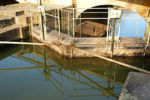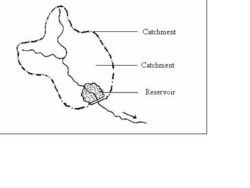CONSTRUCTION OF SMALL EARTH-DAMS
By the end of this lesson you will be able to:-
|
Contents
- 1 Introduction
- 2 Selection of a suitable dam site
- 3 Identification, selection and collection of construction equipment, tools and materials and labour availability
- 4 Conditions to be observed when constructing an earth-dam
- 5 Planning and design of a small earth dams
- 6 Steps to follow during the construction of an earth dam
- 7 References
Introduction
Small-dams are structures that are constructed across streams/rivers to create artificial lake or reservoir behind themselves. The purposes which these reservoirs are meant to serve may be either for flood control or conservation purposes. Conservation of water may be required for any one or more of the following purposes-irrigation, domestic water supply or livestock water supply. Generally these dams have different sizes, but typical small-earth dams have the following dimensions: Length-60m, depth-3m and width-5 to 10m. The construction of this type of dams can be done using human labour, draft power or machinery.
Selection of a suitable dam site
In order to get a suitable area for construction of the dam, the following factors have to be looked into and examined thoroughly:-
- The catchment area (Figure 1) must contain few residents and livestock in order to avoid the possibility of soil erosion and siltation. Alternatively, where cultivation is taking place, soil and water conservation measures must be implemented. The measures include: construction of stone barriers, strip-cultivation, construction of contour bunds etc.
- A good earth-dam should have a high depth to length ratio. That is, the surface area should be small but the water depth should be very deep to ensure that more water is stored. (Figure 2).
- For economic feasibility, it is necessary that the length of the dam wall should be as small as possible and for a given height, it should store the maximum volume of water. It, therefore, follows that the primary consideration for locating a dam site is that the river valley at the site should be relatively narrow but should open out upstream to provide a large basin for a reservoir. The configuration of contours required for such a site will follow a general pattern similar to that shown in Figure 3.
Identification, selection and collection of construction equipment, tools and materials and labour availability
Large quantities of construction materials are required to build the structure of an earth dam. It is therefore necessary for economic feasibility that the bulk of the materials required for the dam should be available in close vicinity of the site. In the construction of small earth-dams, the tools and materials required may include some of the following:
Conditions to be observed when constructing an earth-dam
Earth dams can be built by using different methods. Examples include; human labour, animal draft power or machinery, heavy earth moving machinery. However, the use of machinery or animal draft power will save time. Good supervision during construction will determine the quality of the dam and whatever method is used the following conditions should be adhered to:
Planning and design of a small earth dams
It is not the intension of this lesson to give detailed planning and design of small earth dams. However. An attempt is made to give some highlights on this.
Steps to follow during the construction of an earth dam
After choosing a suitable site for the dam, it is important to follow the following steps during and while constructing the earth dam.

References
Glenn. O. Schwab, Kenneth K. Barnes, Richard K. Frevert and Talcott W. Edminster (1971). Elementary Soil and Water Engineering 2nd Edition) 193pp, 196pp, 201pp.

